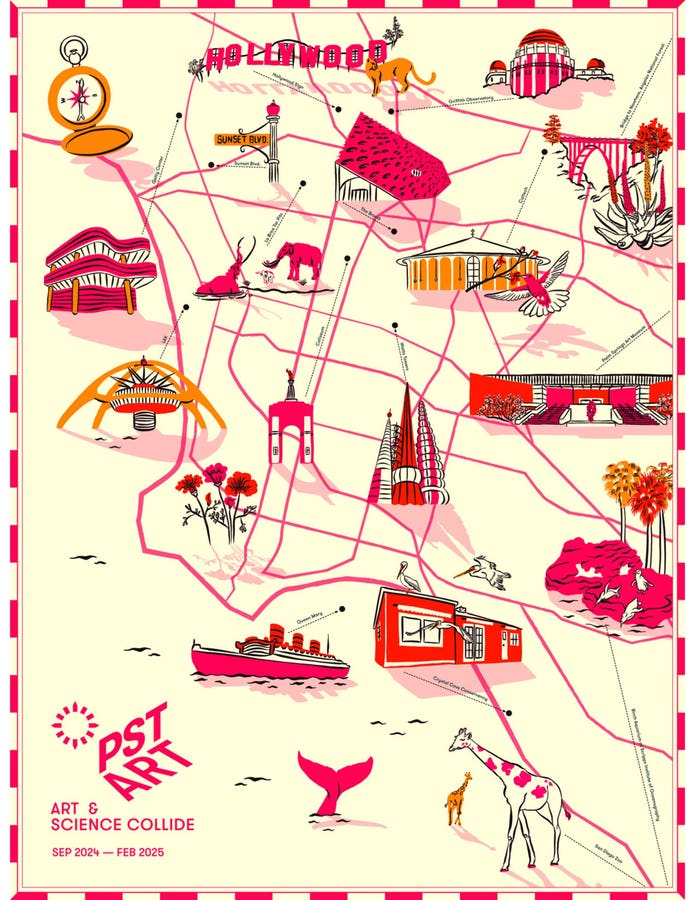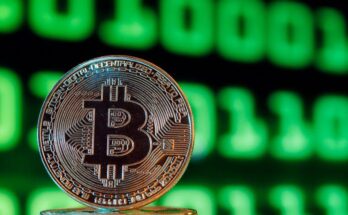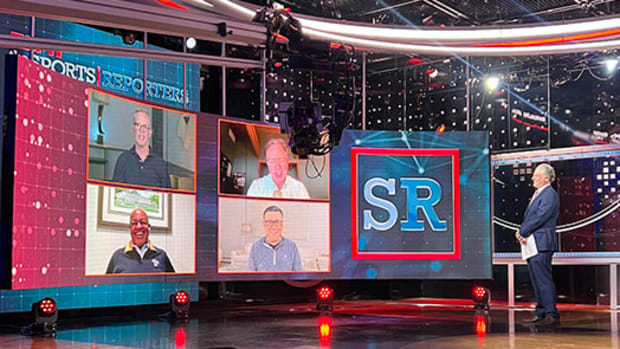Poster for PST: Art & Science Collide
Courtesy of PST Art & Science Collide
This weekend, after a full week of press conferences that attracted journalists from around the region, the country and the world, PST ART: Art & Science Collide be initiated. Pacific Standard Time (PST) is an initiative of the Getty Museum and its Foundation that over the next five months will see more than 70 exhibitions related to the Museum, galleries and public spaces throughout the Southern California from San Diego to Pomona, Riverside, Palm Springs. , and Orange County.
This is the third event of the Pacific Standard period, which begins in 2030 and will be an event once every five years. The first PST, Pacific Standard Time: Art in LA 1945-1980 which opened in October 2011, accurately documented New York’s art history to include the importance of Los Angeles and California. If you’re looking for an event that started in LA to rise to the art capital of the world, this is it.
In September 2017, the second phase, Pacific Standard Time: LA / LA, to explore the relationship between Los Angeles and Latin American artists and Latino artists in LA, was held. More than 70 art centers held related exhibitions, which were important to the recognition of Latin American artists and the influence of Latin American heritage and culture, but which did not gain influence among the public what the first PST did.
PST Fun Fact: Dr. Kathryn Fleming, Getty’s President and CEO told us at the press conference that the name of the initiative was changed from Pacific Standard Time to PST because when you used Google before what you found was the time and not the art event. .
Now, with nearly $20 million in grants from the Getty Foundation, PST: Art and Science will be the largest art event in the United States, with more than 70 cultural organizations participating. in the next five months.
Last weekend I went to more than a dozen shows. Many museums have gathered treasures from their collections to put on display, many of which have never been seen by the public before; others received unusual loans for things that never left their country.
Over the next few months, I’ll be writing about a few of the more unusual offerings on the horizon, but some of the ones I’ve seen and already recommend include (in no particular order).
Pure Power and Neurotic Man, 1940-41 Barbara Morgan (American, 1900-1992)
Getty Museum Courtesy of Barbara and Willard Morgan Photographs and Papers, UCLA
At the Getty Center: The Getty has several exhibitions as well as the works of contemporary artists, all linked to the theme of Light – There is a fascinating exhibition of experimental photography, The Light Is Tested: Experimental Photographybeginning at the end of the 19th centuryth Century, and provides Man Ray Rayographs, and that creates holograms.
Lumen: The Art and Science of Light it displays the most brilliant manuscripts I have ever seen in one room; and there’s an incredible performance of Helen Pashgian’s work that doesn’t make sense — and that’s not all of The Getty’s shows.
photo © Museum Associates/LACMA
At LACMA, there is an amazing exhibition, We Live by Painting: The Form of Color in Mesoamerican Art which has assets that have never traveled outside of Mexico; and a demonstration of the techniques that allow for a different rendering of video art that I found thought-provoking.
Mark Dion, Excavations, View of La Brea Tar Pits installation
Courtesy of the Natural History Museums of Los Angeles County. The installation photos have c
One of my favorite shows I’ve seen before is install, Mark Dion: ExcavationsAt the La Brea Tar Pits Museum. Dion became involved in all aspects of the museum’s work, and eventually produced detailed works that appear as photographs of artifacts that Dion made detailing the collection of Los Angeles, including LA clubs, locations of neighborhood, famous people… in unusual, funny ways, and will undoubtedly provoke a difference of opinion.
Installation view Breath(e) installation view Hammer Museum exhibition
© 2024 Sarah M Golonka | smg-foto
The Hammer has a powerful display, Breathing (e): Towards Climate and Social Justicecurated by artist Glenn Kaino and curator Mika Yoshitake and featuring artists Brandon Ballengée, Mel Chin, Tiffany Chung, Ron Finley, LaToya Ruby Frazier, Cannupa Hanska Luger, Ryoji Ikeda, ikkibawiKrrr, Michael Joo, Danil Krivoruchko, Xin Nau Otobong Nkanga, Roxy Paine , Garnett Puett, Rob Reynolds, Sandy Rodriguez, Sarah Rosalena, Bently Spang, Mika Tajima, Clarissa Tossin, Lan Tuazon, Yangkura, Jin-me Yoon, Zheng Mahler.
Among PST’s offerings are exhibits at The Griffith Observatory, CalTech, Museum of Natural History, The Broad, MOCA, The Autry, The Wende, San Diego Museum of Art and UC Riverside museums. UC Irvine, and UCLA, Birch Aquarium at Scripps, and Jet Propulsion Laboratory, SciArc, Art Center Pasadena, Institute of Contemporary Art, Los Angeles. The Academy Museum and the Hammer each have their own series of films looking at images from recent science fiction films. And that, too, is not an exhaustive list but gives you an idea of the breadth of the effort.
Lita Albuquerque in front of one of her new paintings at the Michael Kohn Gallery
©McHugh. Courtesy of the artist and Michael Kohn Gallery
Among the gallery exhibitions, I will mention only two: Lita Albuquerque: The Skin of the World at Michael Kohn Gallery and Thom Mayne: Shaping Accident at LA Louver. Albuquerque, who I recently profiled for the Alta Journal shows an amazing new work, full of movement, canvases where the paint’s gestural swooshes seem to dance. Thom Mayne is an award-winning architect who recently started exhibiting his art. These are just two, but there are also PST-related exhibitions at galleries all over Los Angeles including Pace LA, Kordansky and many more.
In addition to the exhibitions there will be public programs in the next five months where scientists and artists will join the discussion, confirming that, as Michael Govan said recently as I have written many times, Los Angeles is the creative capital of the world. a continuing center of innovation in the arts and sciences.
The question that looms over all of this is: Will it work? How do we measure success? We will have to wait for them. But time seems to be good: LA now has art schools, artists, museums, international and local galleries and collectors that create a good art environment. Science, especially as it relates to AI, is top of mind and we are all connected to our electronic devices. Los Angeles itself is preparing for the World Cup in 2026 and the Olympics in 2028. For PST ART: Art and Science Collide, the time is now.
As Marcel Duchamp, the father of conceptual art who spent his time in LA, once said: “What art really is, is this missing link, not the existing links. It’s not that.” what you see is art; art is a gap.”
#PST #Art #Science #Collide #Los #Angeles



